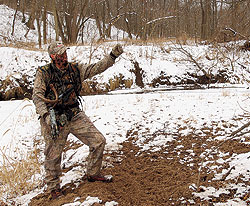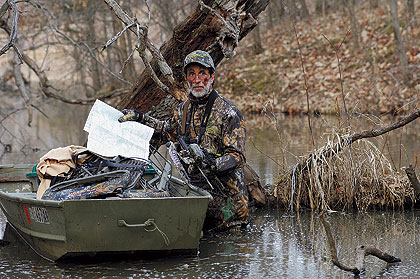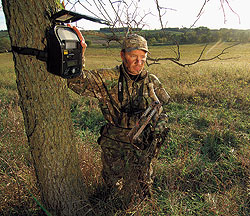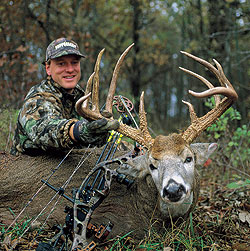October 28, 2010
By Bill Winke
Accelerate your learning curve 20 years in 20 minutes with these bowhunting breakthroughs.
By Bill Winke
Becoming a better whitetail hunter is not as much about learning specific strategies as it is about adopting a philosophy that will produce its own strategies. There really aren't very many things you need to understand to come up with a good plan this fall, but you really need to understand those few things well.
This article is about my own evolution from total novice to consistent deer harvester. Several milestones along the way coincided with breakthroughs in my understanding. It took nearly 20 years before whitetail hunting started to become simple. I didn't say "easy," just simple and clear. Chances are, you'll find yourself somewhere along the timeline of my personal hunting evolution. I hope my experiences will help you climb the learning curve a lot faster than I did.
Advertisement
The Clueless Years
I got into bowhunting when there wasn't much out there in the way of instruction. There were just two magazines dedicated to bowhunting and three or four general interest magazines that touched on deer hunting with a gun. To be honest, most of the stuff I read was useless, because the people writing it just didn't have enough genuine deer-hunting experience to offer anything useful. They would tell about their first deer with a bow, or whatever, and it could have been pure luck.
There weren't a lot of deer back then either. So, there weren't many hunters who had actually killed large numbers of them with a bow. I would simply go out into the woods and sit on a stump hoping a deer would walk past. I knew nothing. I remember one time I saw doe while I was walking to my stump and I starting shaking so badly I couldn't even get an arrow on the string. That was back in the late 1970s.
Advertisement
 It is easy to be lured by large sign into making bad stand decisions. When deciding where to hunt, don't let obvious sign lure you in. Sign is just one small part of the puzzle. |
The first ray of light in those early days came from Gene Wensel's book, "Hunting Rutting Whitetails." It remains a classic. I studied it as if it was the word of God Himself.
Gene was big on using sign to pattern bucks, and his book motivated me to scout my hunting areas as soon as the season ended. He was the first person I knew of to suggest such an undertaking. It is amazing it took until the early '80s for someone to put this into print.
Think about it. Just 26 years ago, no one even thought about post-season scouting. This really is a young sport we are engaged in, and that means new understandings and new hunting philosophies are taking shape all the time.
OK, so there I was in the early '80s, a college kid armed with a Wensel book and a Browning Safari bow. I knew only that I was supposed to piece together all the deer sign I was finding into some kind of pattern that would tell me when and where to hunt.
Computers were just starting to become popular at that time too, and I took to the project of patterning deer as if I were programming a computer. I believed if I found a certain kind of sign I was sure to see a nice buck within a short time. After all, I had cracked his code. He would have to show up, right?
 Be creative in how you access your stands and you will be rewarded with much better success. |
Well, no. Unfortunately, there is no code, and I labored under the misconception that there was a code for the next decade. It was 10 years of futility, always learning the hard way. I figured if I wasn't seeing the bucks that were supposed to come past, I simply hadn't found the right sign or hadn't interpreted it correctly. I kept scouting for better sign, and I kept moving my stands.
I was a sign hunter. If I saw a big, calf-sized rub or a bathtub scrape, I felt I had the buck licked. I had only to sit over the rub line or near the "primary" scrape and he would be mine. Things just never worked out that way. I always felt like I was one step behind the action. It never made sense.
Breakthrough No. 1
Understanding Deer: My initial approach to hunting bucks was too one-dimensional. I didn't really know anything about the deer. I just knew how to identify their sign. You can probably train a monkey to do that. I needed to raise the level of my game.
Unfortunately, you don't just wake up one morning and realize you have a deficiency.
There aren't deer-hunting doctors running around diagnosing what is wrong with your strategy. You only realize you are going down the wrong road after years of failure convince you of the fact. Then, you have to go searching for something better based only on the fact that you now know one strategy that doesn't work. It takes a long time to learn all the strategies that don't work. It is far better to learn about the deer themselves and let that knowledge suggest better strategies.
That happened for me in 1994 or 1995. My philosophy on deer hunting turned inside out and upside down when I realized I was going down the wrong road. Killing bucks for me was pure chance. I was always behind the action. Discouragement created a desire for change, and the desire for change brought on revelation. I was hunting where the bucks had been and not necessarily where they were going to be next. It took 10 years for me to figure that out. Again, the monkey would have gotten to that conclusion faster.
In order to flip-flop my approach so I could get out in front of the action, I needed to learn more about deer so I could anticipate rather than react. I needed to know what they would be doing next, and that only comes from knowledge.
 Trail cameras offer the next big breakthrough in the way the author hunts. He knows that they will help him to pattern bucks and help him decide which areas to focus his hunting time. |
Experience proved t
o be the best teacher -- really the only teacher. Much of the material available to study in the early '90s was either too academic or too general. There wasn't much practical information in the middle. We were all learning together.
The most important points I took from those next five years will seem basic now, but at the time it was revolutionary -- at least to me. First, I learned that sign plays almost no role whatsoever in whether I will shoot a nice buck. Wow, that was a big hurdle to overcome, given my starting point. By the end of the 1990s, I had given up on deer sign.
Second, I learned there are simple principles that govern deer activity at nearly every stage of the hunting season. You just key in on the behavior you know is coming, set your stands accordingly and put in your time. It is really not a very complicated process.
In fact, deer hunting has become simpler for me every year, instead of more complicated.
That is because year by year, the complicated strategies proved worthless. So, I threw them aside.
Here are the simple principles I now live by: Deer are creatures of habit. They are slaves to their stomachs.
During most phases of the rut, bucks are looking for does. It is very hard to kill a buck that knows you are hunting him. That's pretty much it. When you truly master these simple principles (and they all imply), you will shoot more than your fair share of bucks.
As easy as these principles are to understand, they are not always easy to apply.
Understanding them is the science of deer hunting. Applying them is the art. The fact it is not all science is why I love this stuff so much. You can never totally master deer hunting. Every minute of every day is unique. You never know what is going to happen next or what you are going to see and learn.
Breakthrough No. 2
Cover And Terrain Are Key: There isn't much that's predictable about the daily behavior of a mature buck. So, you have to take full advantage of those few things that are. You can usually count on the fact bucks will use terrain and cover to their advantage. They will use these features to increase their security while traveling and to make their travels less strenuous. They take the path of least resistance any time it doesn't expose them to danger.
Once I figured this out, I completely stopped looking for sign when scouting and focused entirely on the lay of the land and the shape and thickness of the cover. Since bucks are traveling most of the time when we are hunting them, funnels formed by terrain and cover are the hot ticket. There are certain terrain and cover features that deer can't easily pass through, so they go around them, creating a funnel.
Conversely, other features of the terrain and cover invite deer to use them. Examples include saddles in a ridge, a brushy hedgerow between two woodlots, a shallow stream, a grassy slough running through a standing cornfield, etc. These also create funnels.
 Winke shot this buck after moving his stand from a tree it had hung in for several years prior. The buck symbolizes the importance of being flexible and teaches the lesson that the first stand location selected is rarely the best one in that area. It takes observation to fine-tune stands. |
Again, the fact deer relate to cover and terrain predictably is a simple concept, but I could write an entire book on how to apply this principle. Fortunately, I don't have to because you can start to think about it yourself and discover these revelations on your own. Never stop learning.
Breakthrough No. 3
Access Is Everything: I already mentioned that bucks are nearly impossible to kill if they know you are hunting them. They often learn this because you use careless entry and exit routes. No matter how good the sign and cover may appear when you are scouting, a stand location is not worth hunting if you alert deer coming and going.
Let this simple principle soak in, and it will completely change the way you think about stand locations and change the way you hunt. Talk about a major shake-up in your hunting philosophy -- applying this principle correctly will definitely put your old style of hunting through a blender! The result is a better, clearer understanding of what produces success, and that makes things simpler.
Breakthrough No. 4
It Takes Years To Fine-Tune Stands: If you get good at scouting, you can put yourself in the right area most of the time when setting up your stands. But rarely will you get into the exact right tree. It wasn't until 2002 that I really figured this out. That year, I moved a stand I had stubbornly hunted for several seasons prior, even though I knew it was a little off. I was too proud to accept the fact I had misjudged the situation when I set it up originally. That is just foolish. After moving the stand, I killed a 165-inch buck the next day. The stand went on to become my best.
I can't hunt that farm any longer, but I have used this same principle many times since.
Now, I just automatically assume I will need to tweak any stand I put up. Usually, that is the case. It takes two or three years of observation before the perfect tree becomes obvious.
That simple change of philosophy gives me motivation to keep observing and asking questions all the time while on stand. I am constantly in search of the most strategic tree -- one that puts me in range of more bucks or makes it easier to get in and out undetected.
The Final Breakthrough
I am still in the process of pulling all the pieces together on my most recent breakthrough — trail cameras.
There is no question you will become a more successful hunter by using trail cameras and learning to accurately interpret what you see. I am still learning here, so I reserve the right to come back with more on this subject in a future year. Suffice it to say I am headed toward yet another major change in my deer-hunting philosophy.
Deer hunting is not complicated once you sort through all the stuff that doesn't work. The only problem is that it takes years to separate the wheat from the chaff. I hope my own learning process, which is still far from complete, will help you avoid some of the trials and errors I endured.
